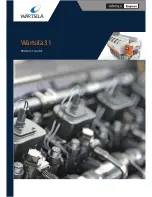
traditional induction machine (IM) technology. The SRPM technology combines the benefits of PM and
Synchronous Reluctance technology, having increased torque capability over wide speed range and
ability to produce torque to higher speeds. The electric machine efficiency at lower speeds is also good.
The supply current to the machine stator windings create rotating magnetic field, which in turn rotates
the rotor containing permanent magnets. In the synchronous permanent magnet machine, the rotation
of the rotor (shaft) is synchronized with the frequency of the power supply current. The reluctance
technology maximizes the pull-out torque of the machine.
The permanent magnets of the rotor are of salient-pole design, having embedded permanent magnets in
the rotor structure. This structure makes the electric machine mechanically more stable and capable of
higher speed operations. See Figure below illustrating the magnet topology of the electric machine. The
Figure shows the principle only, and is not an exact illustration of the structure.
Machine topology
1
Electric machine stator and stator windings
2
Electric machine rotor
3
Permanent magnets in the rotor
System introduction
Danfoss provides electric drive trains for applications in heavy mobile work machines, marine vessels and
buses. The drive trains include all essential components for converting from traditional to hybrid electric
(HEV) or electric vehicle (EV) solutions. Danfoss technology saves fuel and lowers emission and noise
levels.
Overview of the Danfoss drive train system
User Guide
EM-PMI540-T4000
Product overview
14 |
©
Danfoss | April 2023
BC265857716810en-000202















































